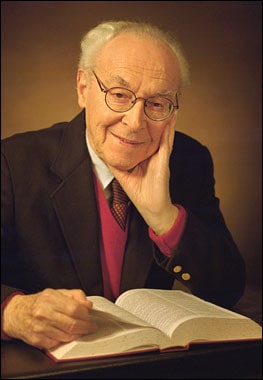
By Matin Durrani
I recently received a copy of the 15 April issue of the Brookhaven Bulletin – the newsletter of the Brookhaven National Laboratory in the US – which described the forthcoming 100th birthday celebration of the physicist Maurice Goldhaber (right, image courtesy of Brookhaven National Laboratory).
The birthday bash took place on 18 April, as planned, so I was so sad to learn, as I did yesterday via the New York Times, that Goldhaber sadly died on 11 May.
Born in Austria on 18 April 1911, Goldhaber was one of the last survivors of the glittering pre-war era that saw so many revolutions in physics.
According to Brookhaven’s online tribute, Goldhaber had worked at the University of Cambridge in the UK with the Nobel-prize-winning physicist James Chadwick, where in 1934 Goldhaber became the first person to measure accurately the mass of the neutron.
After obtaining his PhD from Cambridge in 1936, Goldhaber moved to the US, joining the University of Illinois. He arrived at Brookhaven in 1950, going on to serve as lab director from 1961 to 1973.
In 1957 Goldhaber famously discovered that neutrinos have a left-handed helicity, which means that their intrinsic angular momentum, or “spin”, is in the opposite direction to their momentum. That experiment was cited by Brookhaven historian and Physics World columnist Robert P Crease in his collection of most beautiful experiments of all time
By all accounts, Goldhaber was one of those physicists who saw physics as not just a job but his life. Although he retired in 1985, Goldhaber continued to go in to Brookhaven most days until he was well into his 90s. He won numerous awards and prizes, sharing the Wolf Prize in 1991 with Valentine Telegdi for their “separate seminal contributions to nuclear and particle physics, particularly those concerning the weak interactions involving leptons”. He was also awarded a US National Medal of Science.
Goldhaber was not alone in his love for physics: he was part of a family of four generations of physicists, including his son Fred Goldhaber and brother Gerson.



